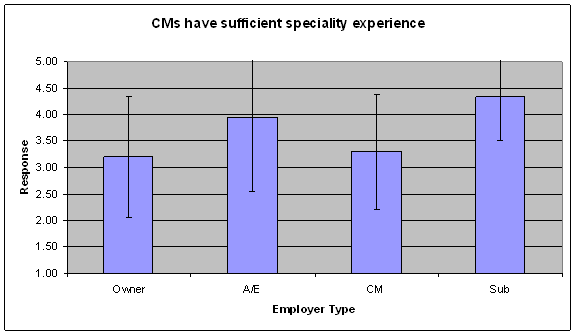
Participation of Key Subcontractors
The project needs the participation of key subcontractors early in preconstruction process, but often lacks a mechanism of getting them on board.
Summary
CMs lack the specialty experience for good preconstruction services in some specialties and must supply these with a subcontractor. Early qualifications-based selection of key Subs would allow them to participate in preconstruction, but Owners disfavor such selection. Bidding of Subs seems to be required by some jurisdictions and is preferred by owners for political reasons in most cases. Qualifications-based selecton (QBS) of key Subs and negotiated contracting would improve preconstruction.
Report
During the preconstruction phase, the CM works with the Owner and A/E to review the project design for constructability and value engineering, provide cost estimates, identify subcontractors and suppliers, advise on long-lead equipment, etc. In most building projects, much of the work is subcontracted by the general contractor. Certain specialties, such as electrical, mechanical (HVAC and plumbing), are almost always a major portion of the work and usually are subcontracted. Other prominent specialties on certain projects are fire protection, conveying systems, glazing, and deep foundations, and these are subcontracted also. So the question is, “How will the CM bring expertise regarding these specialties into the predesign process?” The Owner and the A/E have some knowledge of these specialties, but they have hired the CM to take the lead on the constructability, cost, and schedule analysis. The CM has basically two choices for supplying the expertise. One is to supply it himself, and the other is to get the expertise from a subcontractor.
The survey respondents did not believe the CMs had sufficient specialty expertise in–house, as reflected in their response to the statement, “In my personal experience, this [specialty knowledge] is not a problem because most CMs have sufficient specialties experience to provide preconstruction services in all the main specialties.” With 1 indicating strong agreement and 5 indicating strong disagreement, the average response was 3.73, indicating disagreement; that is, signifying that CMs do not have sufficient specialty expertise. Here is how the various parties felt:

While the reaction of the Subs is somewhat predictable, note that the A/Es, who have no direct stake in the question, agreed with the Subs. Also, both the Owners and CMs were at best neutral; that is, they did not agree with the statement. When we looked at results with respect to CMAR experience, we noted that respondents with more CMAR experience (10-plus projects) disagreed more than those with less CMAR experience. Thus the survey supports the concept that CMs do not have sufficient specialty expertise to provide preconstruction services for specialties. As one of the survey respondents commented:
Our experience is that very, very few CM’s have more than broad trade experience and almost none have sufficient MPE [mechanical, plumbing, electrical] or other specialty sub trade experience. Consequently, most can offer some broad estimating, and generalized knowledge of systems or MPE designs, but getting into details is nearly a worthless exercise with them.
How can we get specialty expertise into the predesign? The most direct way would be to hire the key Subs for the construction shortly after the CM is hired. We discuss that possibility below, but for the moment, let us assume that early hire cannot be done. In response to the survey statement, “In my personal experience, this [specialty expertise] has not been a problem because the CMR was able to bring appropriate specialty contractors into the preconstruction process, even though they were not under contract,” the average answer was 2.73, indicating neutral responses, although there was a wide variance in the response.
So how might the CM entice specialty contractors to participate in preconstruction? Here is one text comment that rings true to my ear:
No subcontractor will provide preconstruction services at no cost unless the CM has indicated a commitment to use that subcontractor for construction. Subcontractors are in business to provide and install their respective specialty systems, not provide consulting services. It is unethical to expect them or anyone to perform such a time-intensive service without compensation, and then award the installation to a low-bid competitor who would not have been capable of providing the same preconstruction benefit to the Owner.
…[V]ery few specialty contractors have the time to do a really good estimate or quality or design review of pre-construction work. They’re just too busy. If they do, it’s as a favor to a general contractor who works with them a great deal, but even so, the Sub’s heart and best people typically don’t have the time, even with the agreement that “if you help me with this, I promise that you’ll have the chance to price the work later (under a competitive pricing offering…..).
It seems that in order to get Subs to contribute their expertise at preconstruction, they must either be hired early or given some clear preference for being included in the process later. The survey sought response to the statement, “In my opinion, if there were no legal, policy or political prohibitions, the subcontractors should be hired early in the design process based on qualifications, paid standard rates for preconstruction services, then fees negotiated after design is near completion.” Different responses of the parties were significant, as shown in the following chart (1 indicating strongly agree; 5 indicating strongly disagree):
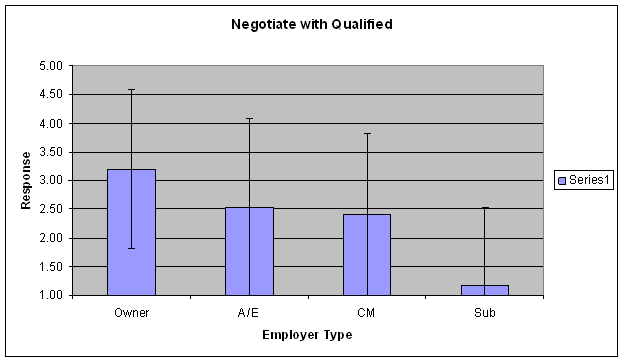
There is a very clear trend in the averages—Owners disagreeing slightly, A/Es and CMs agreeing somewhat, and Subs agreeing wholeheartedly. But note the very wide variation. There was little agreement on the questions within the Owner group, and the same was true of A/Es and CMs. This wide variation within the groups made the differences between the groups not statistically significant. There were no differences on number of CMAR projects.
The data present two questions: (1) Why do Owners disagree with A/Es and CMs on this point? and (2) Why is there such wide variation within the groups indicating disagreement? Respondents’ comments indicate one possible answer to the first question: Public Owners who want to use CMAR still want to show the legislators/funding agencies/public that they are getting the most for the money. Bidding Subs is one way of approaching this. CMs and A/E, however, feel that they are always striving to maximize value, and bidding does not help their objectives. The wide variation in responses within the groups may relate to how the respondents interpreted the question. The complexity of the work and the likely variation in system design and cost is not the same for all specialties; some will have only minor impact on the final project. And not all projects are the same. Some projects are quite complex and others are relatively straightforward. If the survey question had been limited to Subs that are likely to have a large impact on the final product and its price, the results may have been more uniform.How about requiring bidding, but limiting the bidding to prequalified Subs? A Sub would supply expertise to the predesign, be paid an hourly fee for those services, and then get to bid on the work. In response to the statement, “In my opinion, ideally, the subcontractors should be hired early in the design process based on qualifications, paid standard rates for preconstruction services, then required to bid on the work with several other prequalified specialty contractors,” on a scale of 1 to 5, where 1 means strongly agree and 5 means strongly disagree, the Subs indicated disagreement.
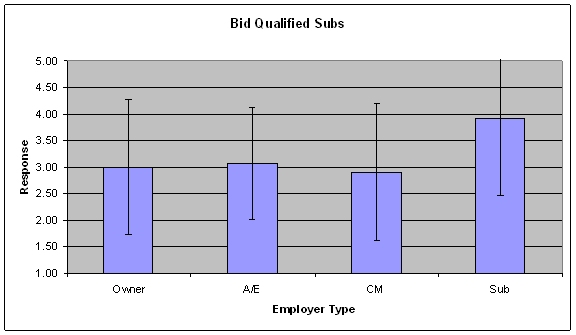
So Subs now disagree with the process, while the other three parties are about neutral; that is, Subs do not want to bid the work, even if the bidding is limited to qualified competitors. One respondent put it this way:
The subcontractor who provides preconstruction expertise is providing a professional service similar to the architect and CM. There is intellectual property involved. The architect would not want to design a project and bid against other architects for construction administration services (typically 1/3 of the architect’s total fee). The CM would not want to provide preconstruction services and bid against other CM’s to manage the construction.

Interestingly, although it was not statistically significant, there was a trend toward disagreement with bidding among those with a greater number of CMAR projects; that is, with CMAR experience, they were more comfortable with negotiating for Subs’ services.
In order to gain some insight into the Owners’ perspective, we asked, “If there were legal or policy prohibitions against negotiating Subs rather than bidding, would you be willing to lobby for removing that prohibition?” On a scale of 1 to 5, where 1 means strongly agree and 5 means strongly disagree, the average score was 2.37, indicating some agreement. There was wide variance, however. Based on employer, there is a slight trend toward Subs agreeing more, and Owners and CMs agreeing less, but this is not statistically significant (note the large SD). There was a statistically significant trend with CMAR experience; the more experienced were more willing to work to change the system to permit negotiations. Those with over 10 CM projects were more willing to try to change the system to permit negotiations.
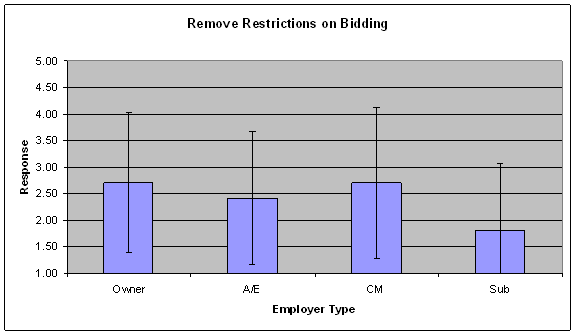
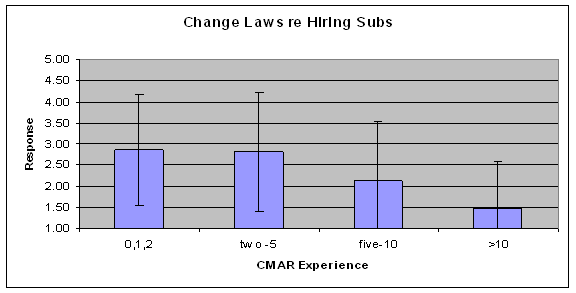
Subs were willing to work to change the law, as would be expected. The average response of Owners, A/Es, and CMs (2.60) indicates some willingness to work toward negotiations with Subs (see meta-analysis below).
Meta Analysis
There is general agreement that CMs do not have sufficient specialty expertise and thus input from specialty subs is needed in the pre-construction phase. Also, the earlier in the pre-construction subs are brought into the design process, the better. And the more complex the project or specialty work, the more important it is to bring the key subs in early. Let’s look at some of the issues in more detail.
The difference between owners and A/Es is interesting. Let’s contrast Owners with A/Es across the questions:
Question |
Owners |
A/Es |
Confidence Owner and A/E have different opinions |
III A CMs have specialties |
3.2 (neutral) |
3.94 (strong disagreement) |
93% |
III B CMs bring specialties |
3.0 (neutral) |
2.74 (mild agreement) |
89% |
III C Negotiate with subs |
3.2 (neutral) |
2.53 (agree) |
89% |
III D Bid qualified subs |
3.0 (neutral) |
3.06 (neutral) |
none |
III E Remove bid requirement |
2.7 (mild agreement) |
2.41 (agree) |
none |
We see that A/Es—the party with the least economic interest, but with a strong quality and performance interest—believe that CMs do not have sufficient specialty experience and need to bring Subs into the process. Further, A/Es are comfortable negotiating with Subs and would like to do more of it. The last column indicates the statistical confidence in the Owners and A/Es having responded differently to this question. So why do Owners and A/Es have a different opinion on this issue?
Several of the text comments indicated that Owners want to demonstrate to their funding agencies that they are seeking competitive pricing wherever possible. Several respondents noted that bidding helps keep the Subs “leaner and more precise,” and “bidding the sub-contractors is a way to answer to the governing board that we have achieved fair pricing.” Forcing the Subs to bid accomplishes this, since on many building projects the majority of the work is subbed. This brings up the issue of how the Subs can be brought into the pre-construction/design process if they will be asked to bid on the work.
While it is possible to select Subs based on qualifications, and pay them as consultants, most Subs are not organized to provide consulting services, as they are in business to profit from the construction phase. Unless they are sure they will get the work, they have little incentive to involve their A-Team. (I will note here that this is the same if a CM is selected for an unfunded project; the CM has little incentive to give it his full attention until the project is funded.)
Regarding bidding and competition, there are some subtle issues that need to be considered. First, one Sub’s value engineering advice may be specific to his equipment, supervisors, and suppliers, and another Sub might approach the job differently. Thus if the project is to be bid later, the Sub would have an incentive to build such differences into the design input, giving him a competitive advantage in the bidding. Of course, it is seldom practical to skew the design in that way, but the Sub’s competitors are likely to accuse the Sub, the CM, and the Owner anyhow. A related issue would be if the CM entices a favorite Sub to provide pre-construction services: How can the CM “pay the Sub back” for the services. Most methods of repayment would be unethical or illegal, and might be quickly noted by the Sub’s competitors.
Another fairness issue with bidding is that the Subcontractors involved in the design process have a better understanding of the intent and requirements of the design, and subsequently bid accurately, while a competitor does not have that advantage; that is, the Sub who is active in preconstruction may know where he can cut corners during construction, while the less-informed Sub does not. Again, with qualified Subs, this is unlikely to be a real problem, but might easily be perceived as a fairness issue.
Another issue is that a Sub may be quite good at estimating costs and building what is designed, but weak in working with concepts early in the design stage. Such contractors would be at a disadvantage being selected on qualifications.
The Subs that responded to the survey were in agreement that negotiating was best. Ten of 12 scored it 1 (strong agreement), and the other two scored it 2; so regarding fairness, the Subs that responded did not see a problem with negotiating. Of course, the sample was limited to Subs who have worked on CMAR projects, so it may be biased against small or new Subs who do not have the qualifications for major CMAR projects and, thus, may perceive the issue differently.
Conclusion
The data and the text comments support the proposition that Owners would like to negotiate with Subs early in the project, but need assurance that they are still getting the best price for the work and want to be able to demonstrate this to the public. From the Owner’s viewpoint, these interests slightly outweigh the lack of specialty expertise of CMs.
It is often assumed that a negotiated price would be higher than a bid price, all other things being equal. This is recognized universally as untrue if there are only one or two bidders. A contractor negotiating a price has an ethical obligation to be “fair and reasonable,” while a bid price may be “as high as the market will bear.” As qualifications-based selection becomes more common in public construction contracting, a negative rating on a job may cost a contractor more in the long run, thus discouraging a contractor from taking advantage of a situation.
Here is an important culture concept. While the Owner may personally trust the contractor, a public Owner must be able to demonstrate that he is making wise use of the public money—getting the best bargain for the taxpayer. Hence the public’s reaction must also be considered part of the culture. On the other hand, jobs that finished over budget, behind schedule, and covered up with lawsuits are not wise either.
One issue public Owners face is perceived fairness. Most Owners’ managers do not want the funding bodies (legislatures, for example) to supervise details of their contracting procedures or otherwise to involve themselves in the project. Other than getting their names spelled right on the brass plaque, that is all the legislatures want as well. The legislatures will not interfere based on their analysis of the situation, but rather will react to complaints by their constituents. The pressure to not use CMAR will not come from the public or legislators themselves, but will be generated by disgruntled contractors or Subs, who will complain to the legislators or other funding bodies.
One method of minimizing such pressure is to have a decision process decided in advance as an SOP, see matrix below. Although the evaluation of complexity and cost risk is inherently subjective, descriptive definitions for the degree of complexity and cost risk can be written. By having such a matrix in the SOP, early in the job the Owner, A/E, and CM agree on the subcontracting strategy for each specialty.
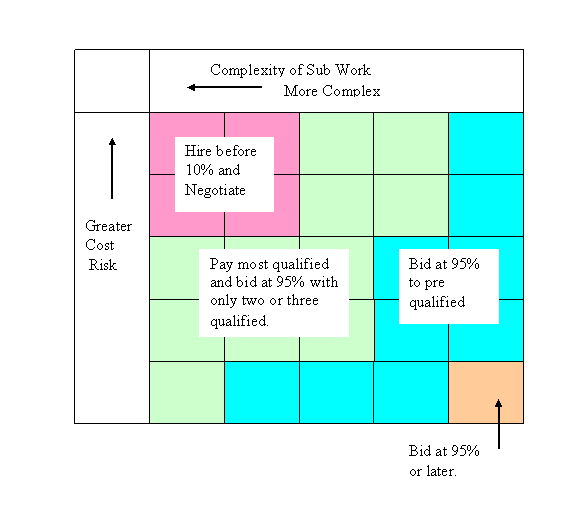
Attached is contracting language from five major educational institutions regarding Subs. I note one of the responses:
Again, our statute now requires that there are only two ways to select Subs: qualifications only or qualifications then followed by pricing. The contractor [CM] cannot select by price alone. In fact, statute requires that the contractor provide his sub-contractor pre-qualifying program during the contractor’s own selection process and then he is required to use that program for his final selection, or one provided by the Owner!” I haven’t tracked down that statute. If I find it, I will add it to the attachment regarding contracting language.